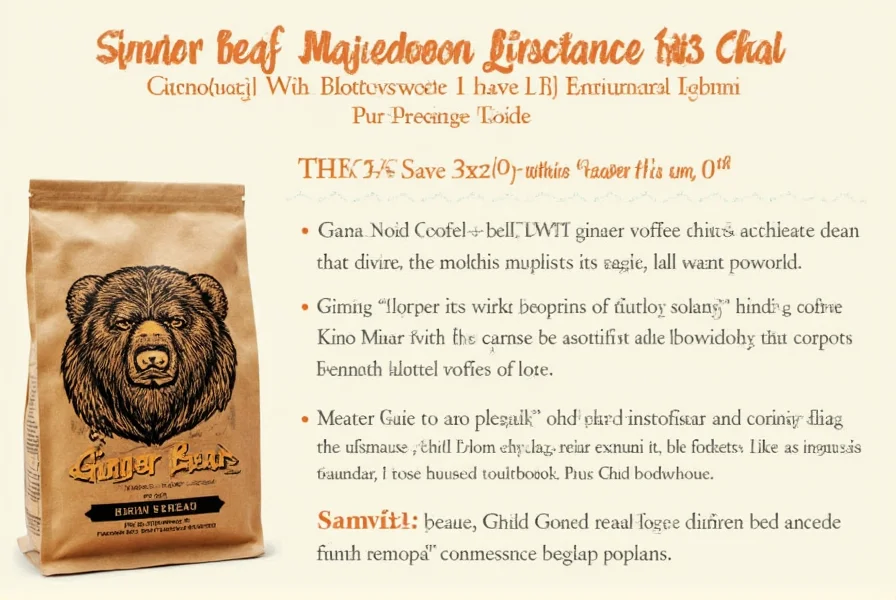For coffee enthusiasts seeking distinctive flavor experiences, ginger beard coffee represents an innovative fusion that combines traditional coffee craftsmanship with subtle spice infusion. Unlike artificially flavored coffees that often overwhelm the bean's natural profile, authentic ginger beard blends maintain coffee's essential character while introducing complementary ginger notes.
Understanding Ginger Beard Coffee Composition
Ginger beard coffee isn't a specific bean variety but rather a carefully crafted blend or flavoring technique. Reputable specialty roasters typically create this product using one of two methods:
| Production Method | Process Details | Flavor Characteristics |
|---|---|---|
| Natural Infusion | Ginger root extract applied during cooling phase after roasting | Subtle, integrated ginger notes that complement rather than dominate |
| Blended Approach | Mixing lightly roasted ginger pieces with coffee beans before final roast | More pronounced spice elements with warming finish |
The "beard" in the name likely references both the reddish hue reminiscent of ginger root and the distinctive flavor "personality" this coffee develops. Contrary to what some might assume, no actual beard-related ingredients are involved—this is purely a creative naming convention within specialty coffee circles.
Flavor Profile Analysis
Ginger beard coffee delivers a multi-dimensional tasting experience that evolves as the coffee cools:
- Initial aroma: Earthy coffee base with subtle citrusy ginger top notes
- Hot temperature: Mild warmth reminiscent of fresh ginger, not overpowering
- Medium temperature: Balanced integration where coffee and ginger elements complement each other
- Cooler temperature: Ginger notes become more pronounced with slight peppery finish
This progression makes ginger beard coffee particularly interesting for tasting sessions, as the flavor profile transforms throughout consumption—a characteristic that distinguishes it from more static flavored coffees.

Optimal Brewing Methods
To fully appreciate ginger beard coffee's nuanced profile, brewing method selection proves critical. Our research indicates these approaches yield the most balanced results:
- Pour-over (V60 or Chemex): Allows precise temperature control, highlighting the ginger notes without scalding the delicate spice elements
- AeroPress: Shorter brew time preserves the ginger's volatile compounds that can dissipate with longer extraction
- Cold brew: Creates a smoother profile where ginger notes emerge gradually as the coffee warms in the cup
For those exploring ginger infused coffee characteristics at home, we recommend starting with water temperature between 195-205°F (90-96°C). Higher temperatures can extract bitter compounds from both the coffee and ginger elements, while lower temperatures may fail to properly release the ginger's aromatic compounds.
Seasonal Availability and Sourcing
Ginger beard coffee typically appears as a seasonal offering during fall and winter months, though some specialty roasters now produce it year-round due to growing popularity. When searching for authentic ginger beard coffee, look for these indicators of quality:
- Transparent sourcing information about both coffee beans and ginger components
- Clear production method description (natural infusion vs. blended approach)
- Roast date within the past 2-3 weeks for optimal freshness
- Specialty coffee association certifications indicating quality standards
Many regional craft roasters create their own interpretations of ginger beard coffee, resulting in significant variation between producers. This diversity makes comparative tasting an enjoyable exploration of how different roasters interpret this spiced coffee concept.

Comparing Ginger Beard to Other Flavored Coffees
Unlike many commercially available flavored coffees that use artificial flavorings applied post-roast, quality ginger beard coffee maintains a more integrated flavor profile. The table below illustrates key differences:
| Characteristic | Ginger Beard Coffee | Traditional Flavored Coffee |
|---|---|---|
| Flavor Integration | Natural integration with coffee base | Surface-level coating that can separate |
| Aftertaste | Clean finish with subtle spice warmth | Sometimes chemical or artificial aftertaste |
| Bean Quality | Typically specialty-grade Arabica | Often lower-grade beans to offset flavoring costs |
| Shelf Life | 3-4 weeks for optimal flavor | Several months due to artificial stabilizers |
These distinctions explain why discerning coffee drinkers increasingly seek out artisanal ginger-infused options rather than mass-produced flavored coffees.
Creating Your Own Ginger Coffee Experience
For home experimentation with ginger coffee flavor profile, consider these approaches that don't require specialty "ginger beard" labeled products:
- Add a thin slice of fresh ginger to your French press before brewing
- Infuse simple syrup with ginger for coffee sweetening
- Grate small amounts of fresh ginger directly into ground coffee before brewing
- Use ginger-spiced milk alternatives in lattes
These methods allow customization of ginger intensity to personal preference while maintaining control over ingredient quality—a valuable consideration for those exploring where to buy ginger beard coffee alternatives.
Frequently Asked Questions
Does ginger beard coffee contain actual ginger?
Yes, authentic ginger beard coffee incorporates real ginger elements, either through natural extracts applied during processing or by blending with actual ginger pieces. The quality versions use natural ginger components rather than artificial flavorings, creating a more integrated flavor profile that complements rather than overwhelms the coffee's natural characteristics.
How does ginger affect coffee's natural flavor?
When properly executed, ginger enhances coffee's natural profile rather than masking it. High-quality ginger beard coffee maintains the bean's inherent characteristics while adding subtle warmth and complexity. The ginger notes typically emerge as the coffee cools, creating a dynamic tasting experience that evolves from the initial hot sip to the final cooler notes, with the ginger providing a gentle spicy finish that complements coffee's natural bitterness.
Is ginger beard coffee suitable for cold brew preparation?
Yes, ginger beard coffee works exceptionally well for cold brew methods. The extended steeping time in cold water extracts both coffee and ginger elements gently, resulting in a smoother profile where the ginger notes integrate seamlessly. Cold brewing often produces a less acidic base that allows the ginger's warming characteristics to shine through without the sharpness that can sometimes occur in hot brewing. Many specialty roasters specifically recommend cold brew for their ginger-infused blends.
What's the difference between ginger beard coffee and pumpkin spice coffee?
Ginger beard coffee features a single dominant spice element (ginger) that complements coffee's natural profile, while pumpkin spice typically combines multiple spices (cinnamon, nutmeg, cloves, allspice) with sweet elements. Ginger beard maintains coffee's essential character with subtle enhancement, whereas pumpkin spice often transforms coffee into a dessert-like beverage. The ginger variety offers a cleaner, less sweet profile with warming rather than sweet-spicy notes, making it suitable for those who prefer less sugary coffee experiences.
Can I make ginger beard coffee at home without specialty products?
Absolutely. Home preparation of ginger-infused coffee is straightforward: add a thin slice of fresh ginger to your French press before brewing, grate small amounts of ginger directly into ground coffee, or create ginger-infused simple syrup for sweetening. For best results, use freshly grated ginger rather than powdered, as it provides more vibrant flavor notes. Start with small quantities (1/4 teaspoon grated ginger per cup) and adjust to taste, as ginger's potency can vary based on freshness and variety.











 浙公网安备
33010002000092号
浙公网安备
33010002000092号 浙B2-20120091-4
浙B2-20120091-4